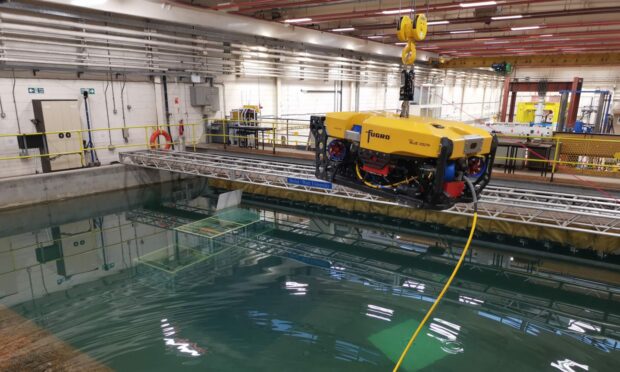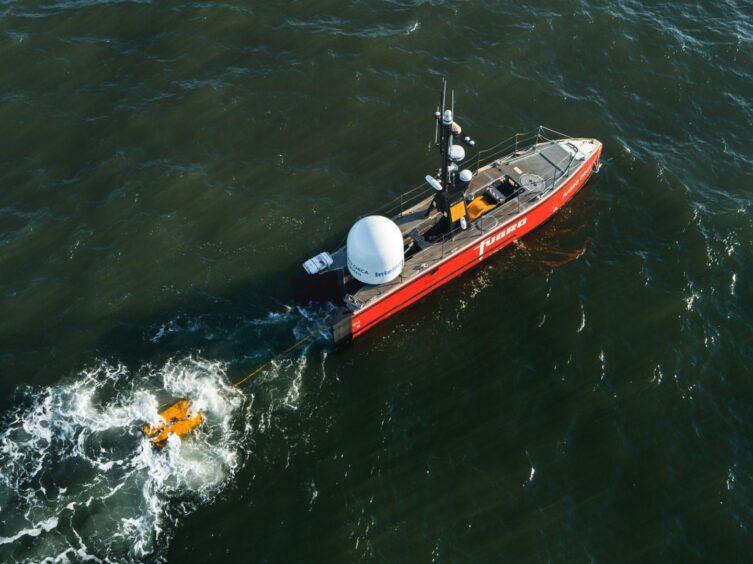Few topics have caught the public’s imagination like artificial intelligence (AI).
Debates surrounding it range from whether it will kill us all through to concerns about unintentional bias being built into models for health insurance prices. Yet, away from the noise and the arguments, companies across the north and north-east are already finding partners to help them develop the skills needed to harness AI in the workplace.
“Our use of AI is still in its infancy but it has great potential,” explained Jan Cees Sabel, innovation manager at Fugro, a Dutch geodata company with a large base in Aberdeen.
Robots working together
Fugro is developing unmanned vessels that can deploy remotely-operated vehicles (ROVs) to inspect the foundations of offshore wind turbines and other subsea structures.
Mr Sabel added: “Uncrewed vessels are smaller, and so use less fuel and can be controlled by operators who are safely back on dry land.”
The National Robotarium, which brings together Edinburgh and Heriot-Watt universities, is helping Fugro develop three-dimensional cameras for its ROVs.
AI is allowing the data collected by the robots to be analysed immediately. They can now automatically work out which parts of wind turbine foundations they still need to photograph, rather than relying on a human operator to tell them. The technology was tested in the North Sea in February by a team of experts from Fugro’s base in Aberdeen.
The next step is for Fugro and the National Robotarium to use AI for helping the ROVs to navigate. It is hoped AI will allow the machines to maintain their stability so they can carry out complex tasks underwater, such as opening or closing valves.
A ROV tethered to a ship on the sea’s surface tends to move about as the vessel bobs up and down on the waves.
Mr Sabel said: “The National Robotarium has been great to work with, because they have the theoretical knowledge and we have the practical expertise and experience.”
How companies can use AI
Other AI developments in the north and north-east involving the National Robotarium include Smartrawl. This is a device that can identify and release fish while they’re still in a trawler’s net to avoid bycatch. The technology is due to be tested later this year on Atlantia, a University of the Highlands and Islands research vessel based in Shetland.
National Robotarium business development manager Lisa Farrell said all parts of the economy can benefit from AI.
She highlighted her organisation’s interactions with the energy, healthcare, and agriculture sectors.
“AI is so powerful – it can be used in any number of ways,” she explained.
“It’s used as a catch-all term, so it’s useful for businesses to understand what AI is.”
Uses of AI include powering speech and image recognition, as well as analysing data through machine-learning algorithms, or computer programs. Ms Farrell also pointed to the creation of “digital twins” – or computer simulations – that allow ideas for equipment or processes to be tested without having to shut down physical production lines.
As well as working with businesses on individual projects, the National Robotarium is also helping individuals develop their skills.
AI is so powerful – it can be used in any number of ways.”
Lisa Farrell, business development manager at the National Robotarium
Ms Farrell said: ““We are working on continual professional development courses people can take, but we’re also developing technology for businesses that just want a ‘plug-and-play’ solution. We know that not everyone wants to become a robotics or AI expert, so we need to deploy systems that work for businesses and their employees.”
Companies can apply for innovation vouchers through Interface – the matchmaking service for businesses and universities – for funding to work with academics on AI projects, she added.
Where businesses can go for help with AI
Companies in the north have the option of contacting economic development agency Highlands and Islands Enterprise (HIE) for help with AI.
Theresa Swayne, HIE’s senior development manager for technology and digital adoption, said: “AI is completely disruptive technology but there’s nothing magical about it. It’s an evolution of computer science and engineering and data science.
“There’s a lot of hype around AI. Our role as an economic and community development agency is to think what practical support we can offer.
Economic drivers including freeports and the space sector facing AI impact
“AI has the potential to impact on our entire economic future and community development here in the region, including freeports, space and net-zero.”
As well as highlighting the opportunities, HIE speaks to businesses about risks associated with AI. There are cyber security and ethical considerations, as well as bias within data to think about.
Part of HIE’s role is to also direct companies towards resources, including the Find Business Support website, findbusinesssupport.gov.scot
The site features webinars run by Business Gateway and The Data Lab, Scotland’s innovation centre for data and AI.
In 2019 The Data Lab teamed up with HIE to launch a regional hub in Inverness. It has worked with businesses on a number of projects, including using AI to improve logistics for food and drink companies.
Hiring staff with AI skills
While many businesses in the north and north-east have been tapping into academic expertise, others are recruiting staff with AI skills.
Lucy Nicoll, associate director in the Aberdeen office of recruitment firm Eden Scott, said: “It’s fair to say AI is a growing area, and more and more investment and training is being dedicated to it.
“The main sectors noticing an increase in AI requirements are, of course, tech and digital, engineering and life sciences.”
New roles are “not specifically AI-led” but knowledge of the technologies is often a requirement of job descriptions, Ms Nicoll said, adding: “Companies need people who can understand and maximise the potential of existing AI systems.”
One recent example was a computational chemist’s role, in which the candidate needed to use machine learning to analyse data from drug discovery projects.
Ms Nicoll is seeing changes in job descriptions for a wide range of positions.
She added: “While it’s not explicitly defined as AI, roles like marketing managers and finance managers are expected to have a working knowledge of systems that make use of AI – like Google Ads, Zapier, and HubSpot – and should know how to maximise the information from these.”






